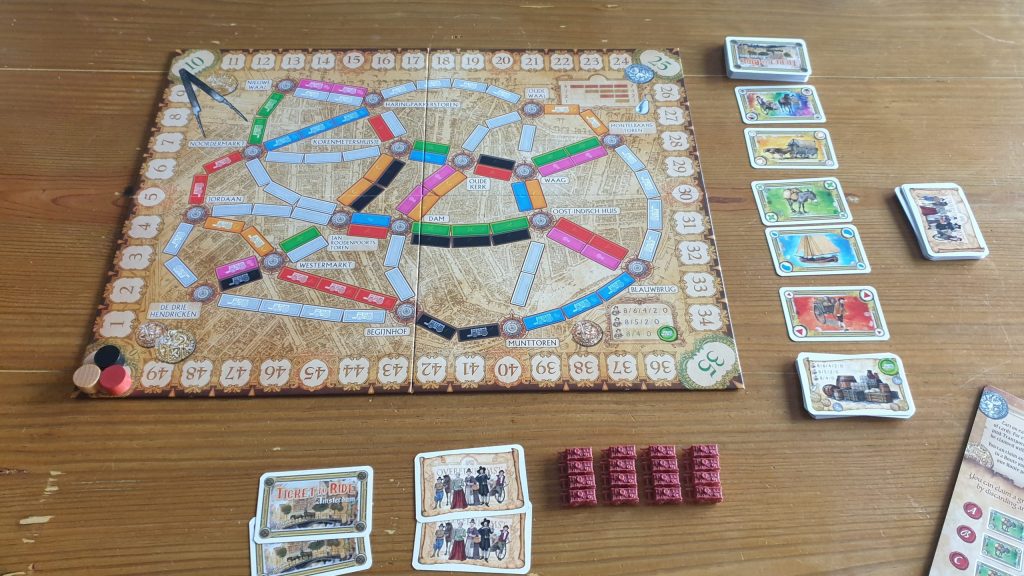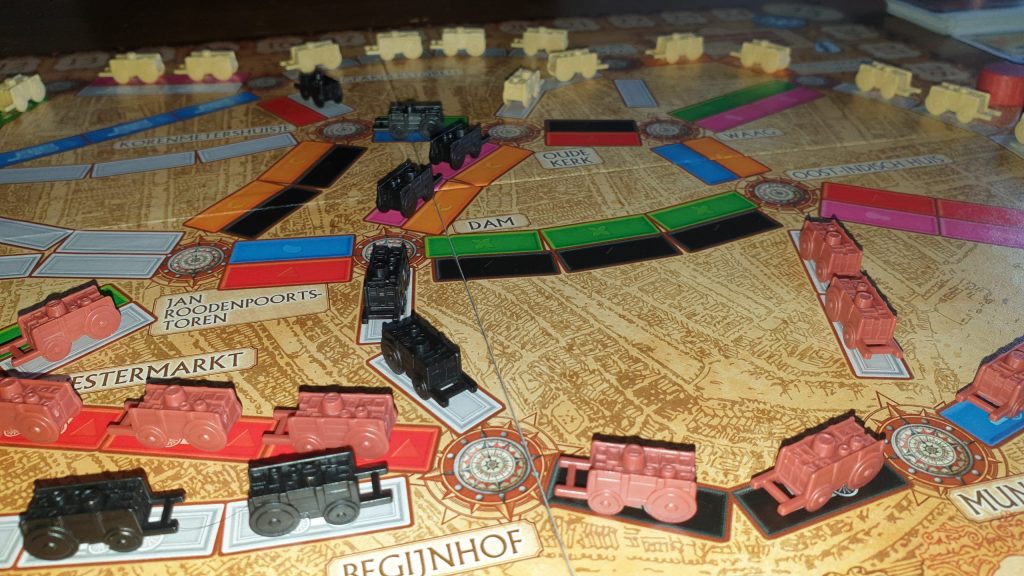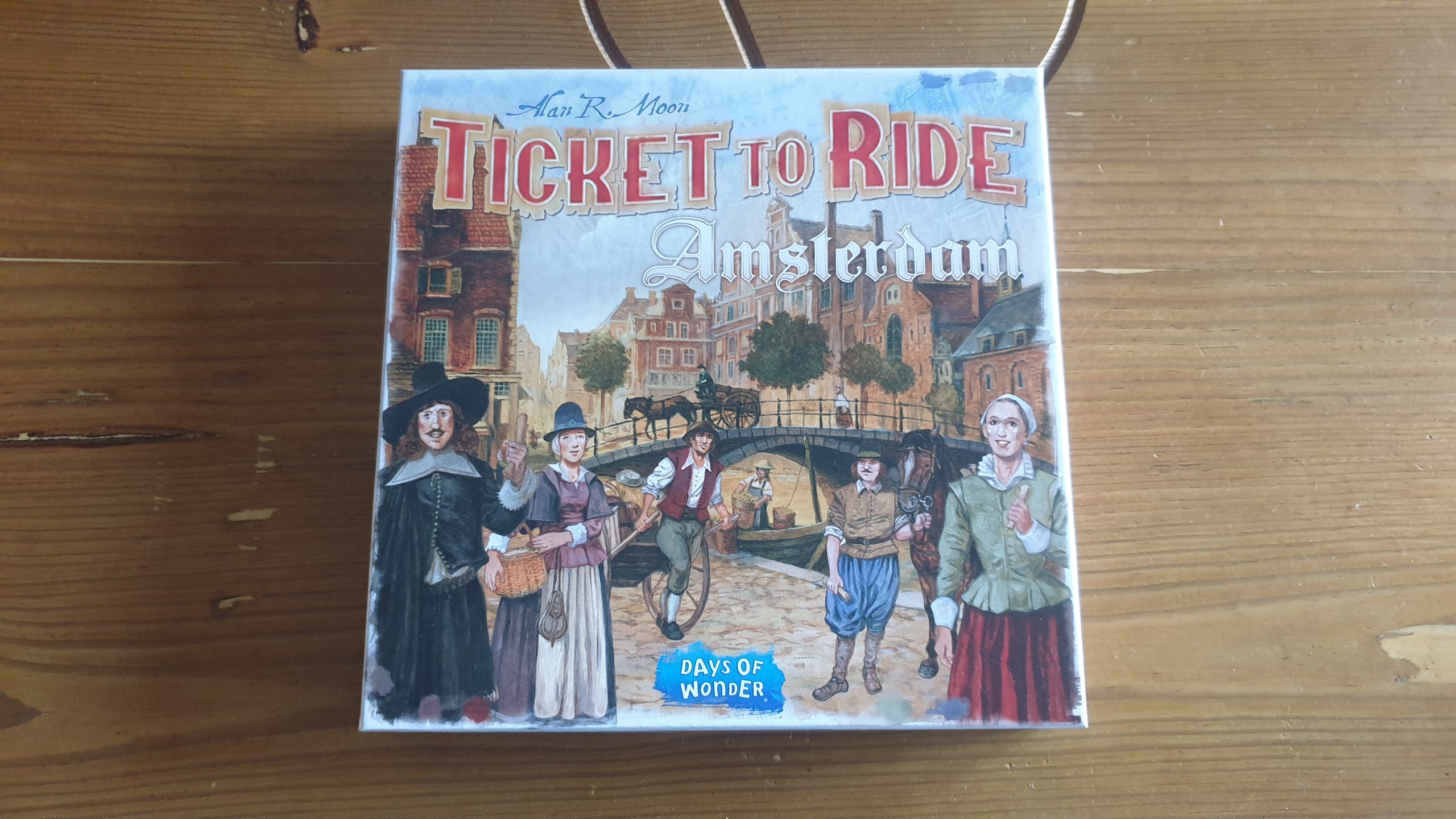Ticket to Ride Amsterdam is the brand new route building, set collection, board game – from publisher Days of Wonder. Designed by Alan R. Moon, this small box version is based on a map of 17th century Amsterdam. Featuring locations such as Westermarkt and Waag, 2 – 4 players will gain cards and spend them to claim routes for around 15 minutes. However, is this one to add to the cart or not? Let’s find out!
Ticket to Ride is normally a train themed game series. Like the previous smaller versions, New York (which featured taxis) and London (which had double decker buses), Amsterdam also has forgone including trains. Instead of using the trams, that can be found in the city in modern day times, carts are used to claim the routes in this old depiction of Amsterdam. Each player starts with 16 of these carts, along with two transportation cards (normally referred to as train cards) and a choice of 2 contract cards (also referred to as destination tickets).
Like the normal Ticket to Ride titles, players can perform one of three actions on their turn – with the general aim to gain the most points. Players can choose to take 2 cards from the available market, or risk a spot of luck by drawing blind off the top of the transportation deck. The only caveat to this is if a multicoloured card is taken from the market it takes up the entire turn – though it can later be used as any colour.
Once a player has gained a set of cards of a specific colour they can trade them in to claim a route. The board is covered with locations which are linked by colourful routes. To claim a route the player must discard a set of cards matching the colour of the route they wish to claim, with the number of cards needed depending on the length of the route. For example, to claim a 3 long red route a player must discard 3 red cards from their hand simultaneously – with the wild multicoloured cards being able to take the place of any of the required cards. Some routes on the board are grey. These routes can be claimed with a set of cards of any colour, though they must all be the same colour – again with the amount depending on the length of the route.

Claiming routes will score points. This can also help players towards their secret contract card objectives. These denote two locations on the board that must be linked by that player. The exact route taken across the board doesn’t matter. If at the end of the game the two stations are linked by the player the points on the card are earnt. If the full route was not made then the player will lose those points instead. As an action the player can draw more of these contracts, drawing two and keeping at least one.
To add a bit of a twist to the normal Ticket to Ride gameplay, Amsterdam has a bonus scoring mechanic. A number of the routes on the board feature cart symbols, with the number depicted not being important. These routes are predominantly around the edge of the map. Claiming any of these routes will gain the player a single merchandise bonus card. At the end of the game, points are awarded based on who has the most of these merchandise cards. Regardless of the player count, the person with the most merchandise cards gets 8 points, with those in 2nd, etc. gaining less points. Note that a player must have at least one merchandise card to gain the associated bonus points.
The game continues with players taking turns clockwise around the table, until one player has two or fewer carts left. Everyone, including that player, then gets one final turn. Players then reveal their contracts to show if they completed them or not. With the points earnt in-game, from the contacts and then the merchandise bonus points combined, whomever has the most points wins.
The twist in Amsterdam may not be as tactical as the connecting zones in London, still it does impact how people play. At the start of the game, players will be trying to complete their contact routes. There is then a shift part way through the game to claim a few of the around the edge routes, to pick up merchandise cards. The points on offer are just enough so that it is an alternative to getting more contracts and drives the competition, without making it impossible to win without getting any points from merchandise.

Production wise the colour palette chosen is on the duller side of things. This matches the time period the game is aiming for, with a real old map vibe from the board itself – despite the more vivid colours of the routes themselves. This toned down colour scheme does extend to the player colours, for example the red is not the normal vibrant red instead being darker. The beige player colour does slightly seep into the background map colour, though the carts do still pop from the route colours.
The carts themselves are small and cute, not taking up the full route spaces – though covering enough to make it clear where something is placed. The cards are also on the small side, which can make them awkward to shuffle – compared to normal playing cards. Nevertheless, the cards do the job well, with the transportation cards each featuring different artwork based on their colour. The contract cards also do a fine job of indicating where the locations are on the board that need to be linked – stopping the hard to pronounce Dutch names of stations from making play awkward or complicated.
We recently reviewed a small box version of the game Pandemic, where we found the shorter than normal length was a detriment to the experience. There aren’t long routes to save up for, which is always a fun part of the full sized maps. Still, players get the feel of collecting sets of cards and building up a mini network, snaking across the board. The reduced time therefore doesn’t negatively impact the experience, plus it makes it easier to get the game to the table – be it as a filler in a game night or for a lunch time game session.
Ticket to Ride Amsterdam sits in the middle of the previous two small box Ticket to Ride titles. It has a little more to think about, thanks to the merchandise bonus cards, than New York – giving it the edge over that experience. Perhaps it is due to the proximity in which I live to London that makes it the more attractive game, with both hitting the sweet spot between a much shorter playtime and still capturing the normal gameplay. If you are a fan of the series then Ticket to Ride Amsterdam certainly doesn’t raise any red flags to avoid it, with it surely massively appealing to those that live or have visited the iconic Dutch capital.
(Editor’s Note: Ticket to Ride Amsterdam was provided to us by Asmodee for the review. The game is currently available from local board game stores, some of which are reopening! Find your local store here.)

